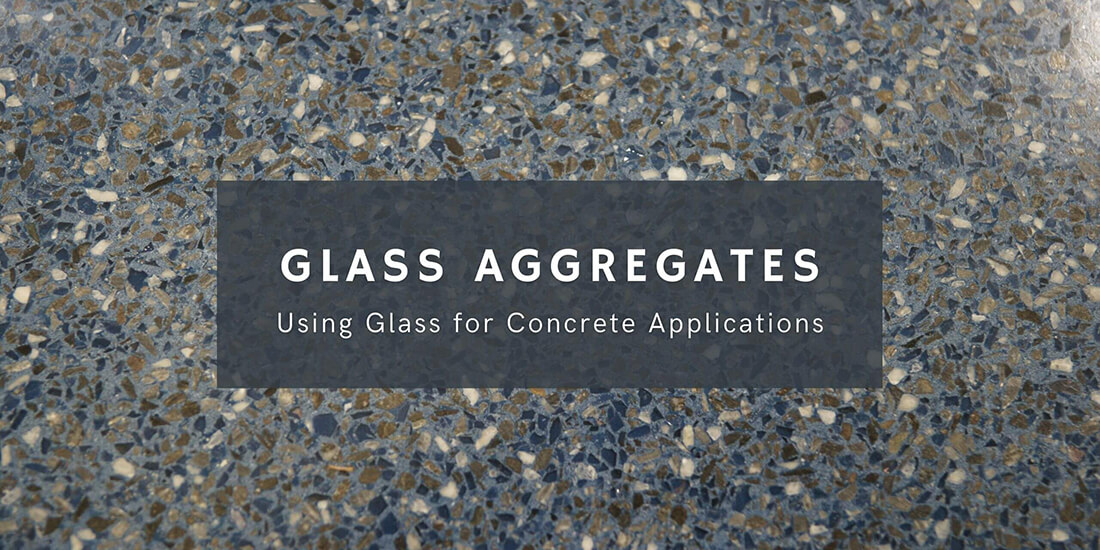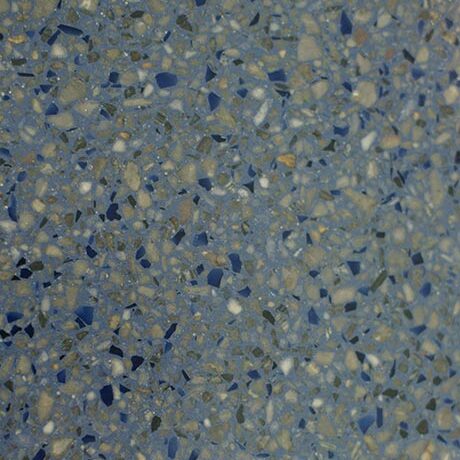23 Feb How to Use Glass Aggregate in Concrete

How to Use Glass as Aggregate in Concrete
Concrete typically consists of sand (fine aggregates) and different sizes of stones and gravel. But what about glass aggregates? There is now interest in the use of substitute materials in concrete, with glass options recommended for recycled material use.
Glass aggregates can even benefit workability and the durability of the concrete finish. Furthermore, glass aggregates are used more often today largely due to their color options. They can add unique colors to the floor finish or even add a highly polished shine. We’ll examine how glass is used in applications such as flooring and countertops, and recommend some of the best colors to consider.
Can Crushed Glass Be Used in Concrete?
It is important for contractors to use clean glass in concrete to prevent issues related to an alkali-silica reaction between the cement and glass aggregates. Many of today’s glass aggregates come from post-industrial sources, which are crushed and cleaned for use in indoor applications such as terrazzo and concrete floors, and concrete countertops. The benefits of using glass in concrete include its color options and its green value to a concrete surface.
Because glass chips are recycled, there is no extraction to retrieve the material and reduces landfill spaces. Finding green materials to work with is essential in today’s construction landscape. and the use of recycled glass contributes to LEED points as well.

Color and Sizes of Glass Aggregates
If you are searching for glass aggregates to use in a concrete finish, two considerations are the size and color of the aggregates.
Glass is graded by size. Glass aggregates can be crushed up to several inches or as small as fine powders, and are not sharp to handle. To reveal the glass aggregates in either a terrazzo or concrete floor, polishing and grinding techniques are employed. Contractors can also use exposed aggregate techniques, or broadcast the glass across the surface and expose it afterward.
In regards to color options, glass is appealing to contractors because of its wide range. Glass aggregates provide color options that can’t be found among gravel or marble chips. You can find colors that range from brown, blue, green, red, and yellow; however, some colors are produced far less than others (red and orange glass) and are priced higher.
When it comes down to composition, a contractor can mix glass with concrete in any way they like. They can pair light glass colors with a dark matrix, dark glass colors with a light matrix, or even match the same glass color to the matrix.
There are also clear glass options, which take on the color of the matrix. This gives the terrazzo or concrete floor depth, and options for clients that require a durable flooring option system but don’t want the exposed aggregates to stand out.
In place of sand, contractors can use fine glass aggregates instead. Studies have shown that glass powder increases the workability, decreasing the time, cost, and energy to install the concrete surface while gaining a highly polished surface with greater strengths.
Overall, the use of glass aggregates allows contractors to explore more design options for their flooring installation while achieving the same great results.
Can Glass Aggregates Be Used in Outdoor Concrete Application?
There are ongoing studies on the effects of glass aggregates use in concrete. When using glass aggregates for outdoor concrete applications, alkali-silica reactions should be evaluated. Outdoor applications or areas where concrete is exposed to moisture are commonplace for this reaction to occur. The silica in the glass and the alkali in cement forms a gel that swells when moisture is present. As a result, this can cause cracks to form.
Can alkali-silica reactions be prevented? The answer is yes. Solutions to the issues include either using metakaolin to suppress the reaction, or grinding the glass finely to pass smaller screens. Another recommended solution is to address the moisture, and sometimes a good sealer can help suppress the reaction as well.
Glass Aggregate Crushing
Concord Terrazzo Company crushes post-industrial and post-consumer recycled aggregates with a cone or jaw crusher, cleaned and processed, and packaged for contractors to purchase for terrazzo or concrete applications. For concrete applications, glass aggregate is commonly in countertops but can be used for floors, walls, and other decorative designs. Another solution is to review epoxy terrazzo flooring and countertops, which go hand in hand with glass aggregates for any indoor environment to produce a durable, beautiful, and low maintenance surface.






